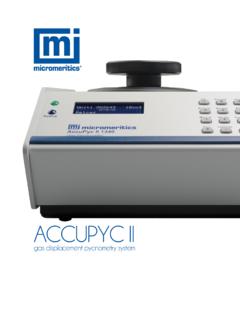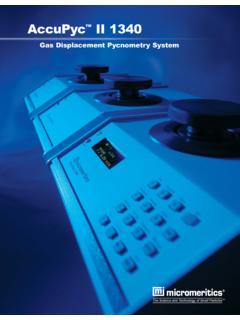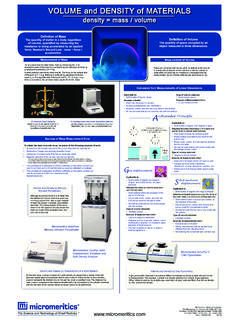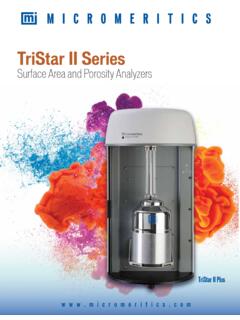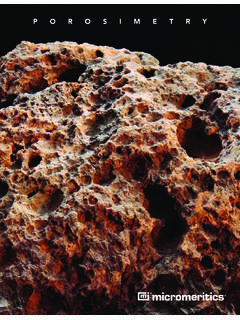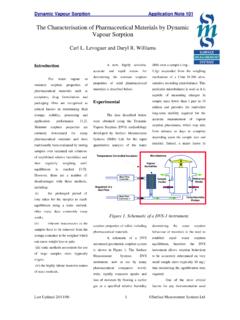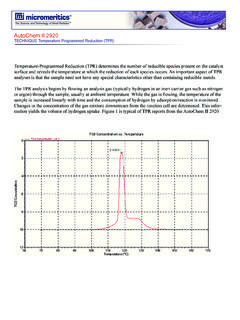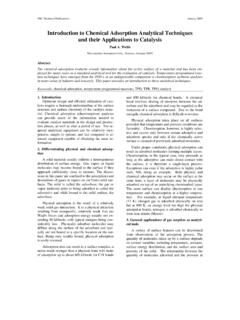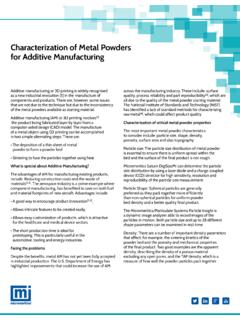Transcription of QbD Solid Fraction Analysis in Roller Compaction …
1 QbD Solid Fraction Analysis in Roller Compaction OperationsAccuPyc 1340 Gas pycnometer GeoPyc 1365 Envelope and Density23 Solid FractionTHE IMPORTANCE OF Solid Fraction DATA IN Roller Compaction OPERATIONSR oller Compaction is a continuous dry granulation process used to increase the bulk density and uniformity of powders into free flowing granules used in downstream manufacturing operations . It is a complex procedure due to the diversity of available powder blends and the control and adjustment parameters involved in the process. The character and homogeneity of the produced ribbon is controlled by a number of factors, such as the properties of the individual powders themselves, roll speed, roll gap/nip angle, and feed speed; all of which subsequently determine the character of the granules produced (size distribution, density and flow behavior).It is critical to produce uniform and specified ribbon densities throughout the process, as well as throughout the ribbon itself.
2 This is important in order to achieve repeatable tensile strength and the desired particle size distribution in the milled material. Specified ribbon densities can be achieved by maintaining equivalent Compaction pressure applied by the rolls on the ribbon for a specified gap distance and speed. In pharmaceutical operations , the Roller Compaction process has a significant effect on the homogeneity, compactability and compressibility of the API, additive/excipient mix. These factors have a direct influence on particle size distribution, porosity, and flowability in downstream operations , which in turn influence dissolution profiles, disintegration time, and hardness of the produced Solid dosage agencies worldwide are now emphasizing the employment of a QbD approach. Companies are being required to show a greater understanding of the way in which variability in raw materials, process design and operating conditions affect final product quality and use this knowledge to implement effective quality control strategies.
3 To date, Roller Compaction operations have utilized mostly mathematical modeling and operator experience as the identified process controls . Solid Fraction , determined through instrumental methods and quantifiable data is an excellent path to achieve Roller Compaction operations that incorporate a QbD policy. Solid Fraction can be used as an important Critical Process Parameter (CPP) and is determined using the following formula:SF= Solid Fraction (relative density) Pe = envelope density of the ribbon Po = true density of the granulesMicromeritics accupyc gas pycnometers are used to determine the true density of a sample. These fully automated instruments can be placed at-line or within a supporting lab. operation for manufacturing process control. They offer precise and rapid determination of the sample s true volume and automatic calculation of density using the associated sample envelope density Micromeritics automated GeoPyc employs a unique, non-destructive, fast displacement measurement technique that uses Dry Flo, a quasi-fluid composed of small, rigid spheres having a high degree of flow-ability.
4 The sample is placed in a bed of Dry Flo which is agitated and gently consolidated about the true and envelope volume measurements are important in their own capacities, their combination permits the pharmaceutical scientist to also accurately calculate percent porosity and total pore volume. With this data a process engineer or quality assurance scientist can better understand and optimize the manufacturing process resulting in a consistent product from one batch to the in tandem, these two instruments can achieve data driven, instrumental Analysis enabling Solid Fraction to be employed as a CCP in pharmaceutical densification 1365 Envelope Density AnalyzerHighly accurate and reproducible results Fast operation in a small bench-top instrumentFully automated data acquisition and reporting Nondestructive Analysis maintains sample integrity Intelligent touch panel for ease of operation and reportingThe GeoPyc employs a unique displacement measurement technique that uses Dry Flo, a quasi-fluid composed of small, rigid spheres having a high degree of flow-ability.
5 The sample is placed in a bed of Dry Flo which is agitated and gently consolidated about the sample. The GeoPyc collects the displacement data, performs the calculations, and displays or prints the unit also reports percentage porosity and specific pore volume when absolute density information (density excluding pore and small cavity volume obtained from a Micromeritics accupyc II pycnometer ) is Density OptionThe GeoPyc density option obtains precise results comparable to conventional density analyzers, only it does it faster, quieter, and with a higher degree of equipped with the Density option, the GeoPyc measures the packed volume and calculates the bulk density of granular and powdered samples, including pharmaceutical and electrochemical materials, under a wide range of Compaction determine density, the sample chamber is rotated and agitated while a user specified force is precisely applied to the sample.
6 A force transducer measures the consolidation force in Newtons and the distance over which the piston travels is precisely monitored and recorded. The user specifies the force applied and the number of consolidations per Analysis . The GeoPyc averages the measurements from each consolidation and automatically calculates volume and density, and reports the results in cm3 a n d g /c GeoPyc automatically determines the envelope volume and density of a Solid object by displacement of Dry Flo, a Solid medium. The medium is a narrow distribution of small, rigid spheres that have a high degree of flow ability and achieve close packing around the object under investigation. The particles are sufficiently small that during consolidation they conform closely to the surface of the object, yet do not invade pore and reproducibility are achieved by a controlled method of Compaction .
7 The sample cell in which the Dry Flo is placed is a precision cylinder. A plunger compresses the powder as the cell is oscillated; the force of compression is selectable and, therefore repeatable from test to test. A preliminary Compaction with only the displacement medium in the cell establishes a zero-volume sample is then placed in the cylinder with the Dry Flo and the Compaction process is repeated. The difference in the distance ht the piston penetrates the cylinder during the test and the distance h0 it penetrates during the baseline procedure (h=h0 ht) is used to calculate the volume of Dry Flo displaced using the formula for the volume of a cylinder of height h, V = r2hThe GeoPyc is operated from an intelligent touch screen. Data acquisition and reporting are fully automated for convenient incorporation in LIMS or other data collection variety of sample chambers is available to accommodate a wide range of sample sizes.
8 After the Analysis , a light shaking or dusting completely removes the Dry Flo so the samples can be reused or retested. The GeoPyc has multiple operating modes including full blank, computed blank, and reference Solid calibration with variance, which allows you to optimize speed and accuracy for your individual needs. During Analysis , indications of progress and preliminary results make it possible to track the progress of the bore glass cylinderPlungerDry Solid mediumBaseline: Solid Medium Only in CellAABM easurement: Solid Medium and Object in CellhSoftwareThe GeoPyc has multiple operational modes that are accessed through the instruments smart touch screen. Operating modes including full blank, computed blank, and reference Solid calibration with variance, which allows you to optimize speed and accuracy for your specific Analysis , indications of progress and preliminary results make it possible to track experiment progress.
9 Sample-specific information can be entered into the Analysis Reports: Envelope Density, Volume Calibration, Blank Report, Force Calibration, Instrument Log67 GeoPyc 1365 SpecificationsReproducibilityWhen sample volume is at least 25% of sample holder volume: Typically ( in.) IDSample volumes between cm and cm ( in.) IDSample volumes between cm and cm ( in.) IDSample volumes between cm and cm ( in.) IDSample volumes between cm and 13 cm ( in.) IDSample volumes between 13 cm and 25 cm PhysicalHeight11 in. ( cm)Width22 in. ( cm)Depth15 in. ( cm)Weight42 lbs (19 kg)Electrical PowerElectrical Power95 VAVoltage85 to 265 VACF requency47 to 63 HzEnvironmentTemperature15 C to 35 CHumidity20% to 80% non-condensing*Due to continuous improvements, specifications are subject to change without IIGas Displacement Pycnometry SystemBenefits8gMaximize your results with superior speed of Analysis , accuracy, repeatability, and reproducibilityAdapt instrument configuration to meet your sample size needsOperate with either a keypad or Windows softwareUse a variety of gasesMaintain product integrity with this non-destructive testEliminate error with programmable automatic repeat and data acquisition set to your tolerances to comply with your SOPsIncrease efficiency and compliance with barcoding compatibilityEliminate procedural steps with direct input from an analytical balanceMinimize cost and space requirements.
10 Low maintenance and small footprintGas pycnometry is recognized as one of the most reliable techniques for obtaining true, absolute, skeletal, and apparent volume and density. This technique is non-destructive as it uses the gas displacement method to measure volume. Inert gases, such as helium or nitrogen, are used as the displacement medium. Density calculations using the gas displacement method are much more accurate and reproducible than the traditional Archimedes water displacement accupyc II 1340 Series Pycnometers are fast, fully automatic pycnometers that provide high-speed, high-precision volume measurements and true density calculations on a wide variety of powders, solids, and slurries. The instrument completes most sample analyses in less than three minutes without sacrificing accuracy. After analyses are started with a few keystrokes, data are collected, calculations are performed, and results displayed.
